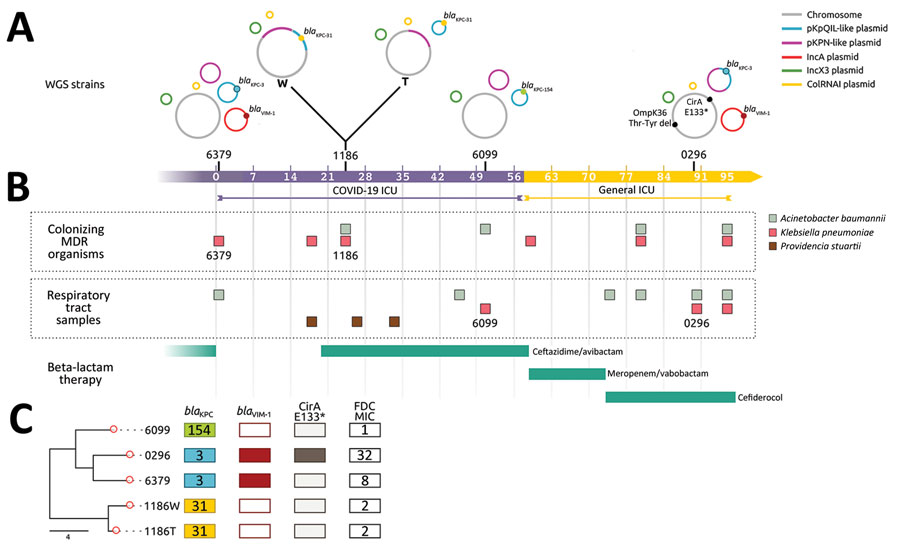Volume 29, Number 11—November 2023
Research
Genotypic Evolution of Klebsiella pneumoniae Sequence Type 512 during Ceftazidime/Avibactam, Meropenem/Vaborbactam, and Cefiderocol Treatment, Italy
Figure 1

Figure 1. Timeline of colonization and infection of 1 patient by Klebsiella pneumoniae clones in study of genotypic evolution of K. pneumoniae sequence type 512 during ceftazidime/avibactam, meropenem/vaborbactam, and cefiderocol treatment, Italy. A) Schematic diagram of carbapenemase genes and plasmid content for K. pneumoniae strains 6379, 1186, 6099, and 0296; strain 1186 comprised 2 phenotypes: W and T colonies. Isolate collection day is indicated during 95 hospitalization days in either the COVID-19 (purple scale) or general (yellow scale) intensive care unit. Asterisk indicates the premature stop codon at position 133 (E133) in the catecholate iron outer membrane transporter CirA. B) Timeline of colonization and infection by K. pneumoniae, Providencia stuartii, and Acinetobacter baumannii as well as β-lactam therapies. C) Phylogenetic analysis used to compare the 5 K. pneumoniae strains isolated from the same patient. Core genome alignments were conducted for 5,215 core genes. KPC variants KPC-154, KPC-3, and KPC-31 are shown according to each strain; the blaVIM-1 gene was present in strains 0296 and 6379. Nonsense mutation in cirA was found in strain 0296, producing a premature stop codon (E133), indicated by an asterisk, in the protein. FDC MICs (mg/L) for each strain are shown. Scale bar indicates number of single-nucleotide polymorphisms in the core genome. FDC, cefiderocol; ICU, intensive care unit; KPC, K. pneumoniae carbapenemase; MDR, multidrug resistant; OmpK36, outer membrane porin K36; T, transparent; VIM, Verona integron-encoded metallo-β-lactamase; W, white; WGS, whole-genome sequencing.